2007 Lexus GS350 tire type
[x] Cancel search: tire typePage 194 of 562
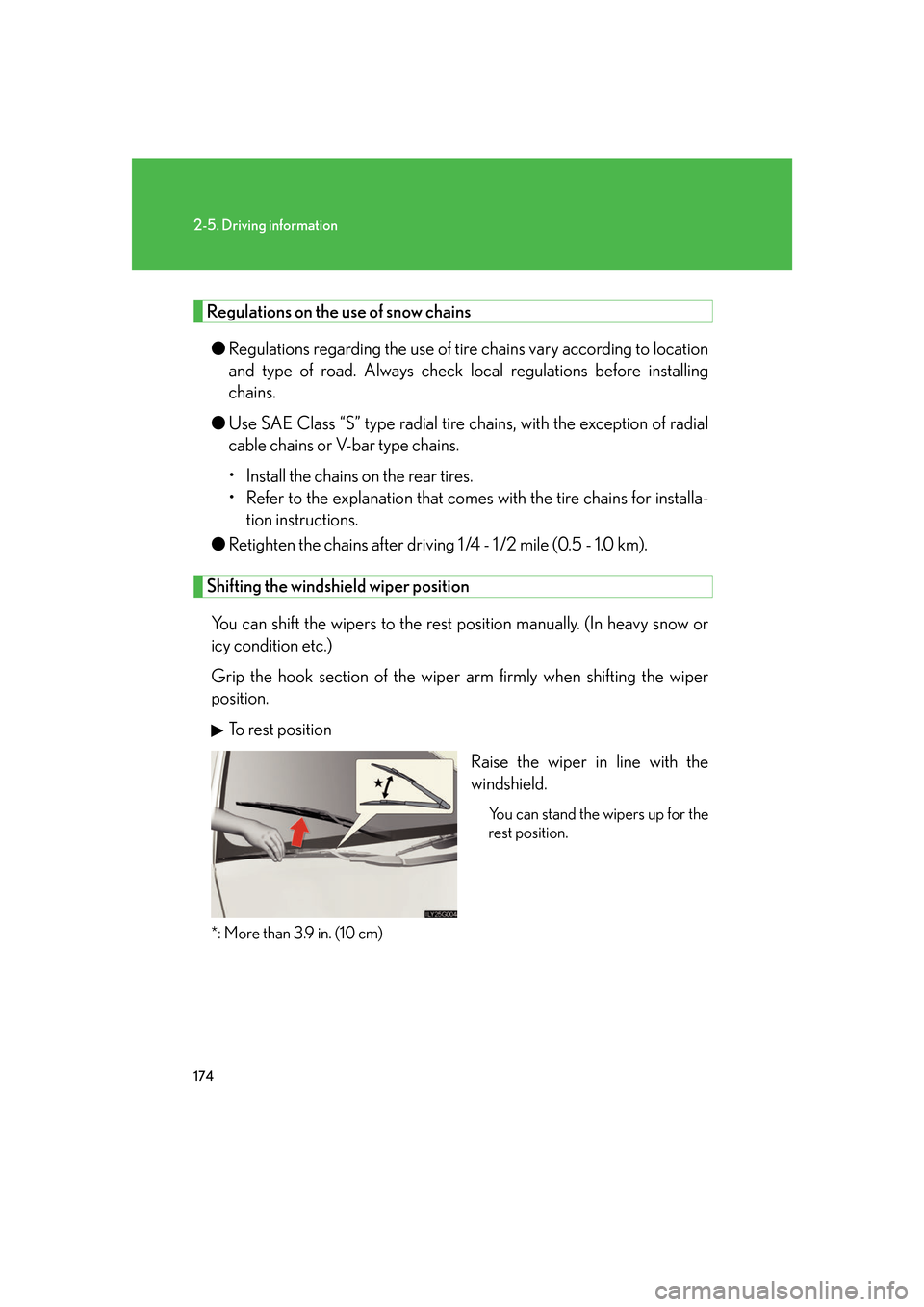
174
2-5. Driving information
Regulations on the use of snow chains
●Regulations regarding the use of tire chains vary according to location
and type of road. Alwa ys check local regulations before installing
chains.
● Use S
AE Class “S” type radial tire chains, with the exception of radial
cable chains or V-bar type chains.
• Install the chains on the rear tires.
• Refer to the explanation that comes with the tir
e chains for installa-
tion instructions.
● R
etighten the chains after driving 1 /4 - 1 /2 mile (0.5 - 1.0 km).
Shifting the windshield wiper position
You can shift the wipers to the rest position manually. (In heavy snow or
icy condition etc.)
Grip the hook section of the wiper arm firmly when shif
ting the wiper
position.
To rest position
Raise the wiper in line with the
wind
shield.
You can stand the wipers up for the
rest position.
*: More than 3.9 in. (10 cm)
Page 195 of 562
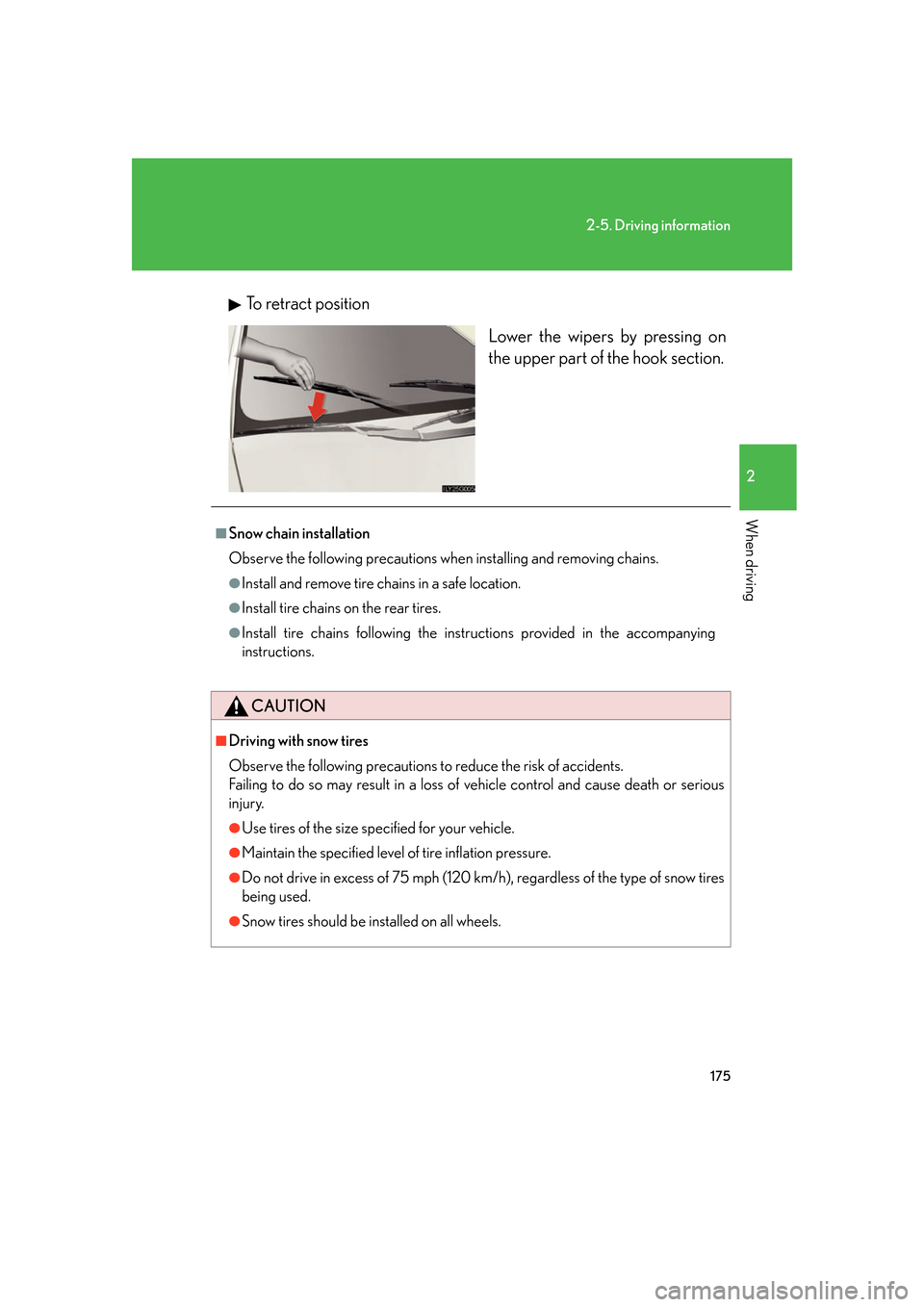
175
2-5. Driving information
2
When driving
To retract positionLower the wipers by pressing on
the upper par
t of the hook section.
■Snow chain installation
Observe the following precautions when installing and removing chains.
●Install and remove tire chains in a safe location.
●Install tire chains on the rear tires.
●Install tire chains following the inst ructions provided in the accompanying
instructions.
CAUTION
■Driving with snow tires
Observe the following precautions to reduce the risk of accidents.
Failing to do so may result in a loss of vehicle control and cause death or serious
injury.
●Use tires of the size specified for your vehicle.
●Maintain the specified level of tire inflation pressure.
●Do not drive in excess of 75 mph (120 km/h), regardless of the type of snow tires
being used.
●Snow tires should be installed on all wheels.
Page 415 of 562
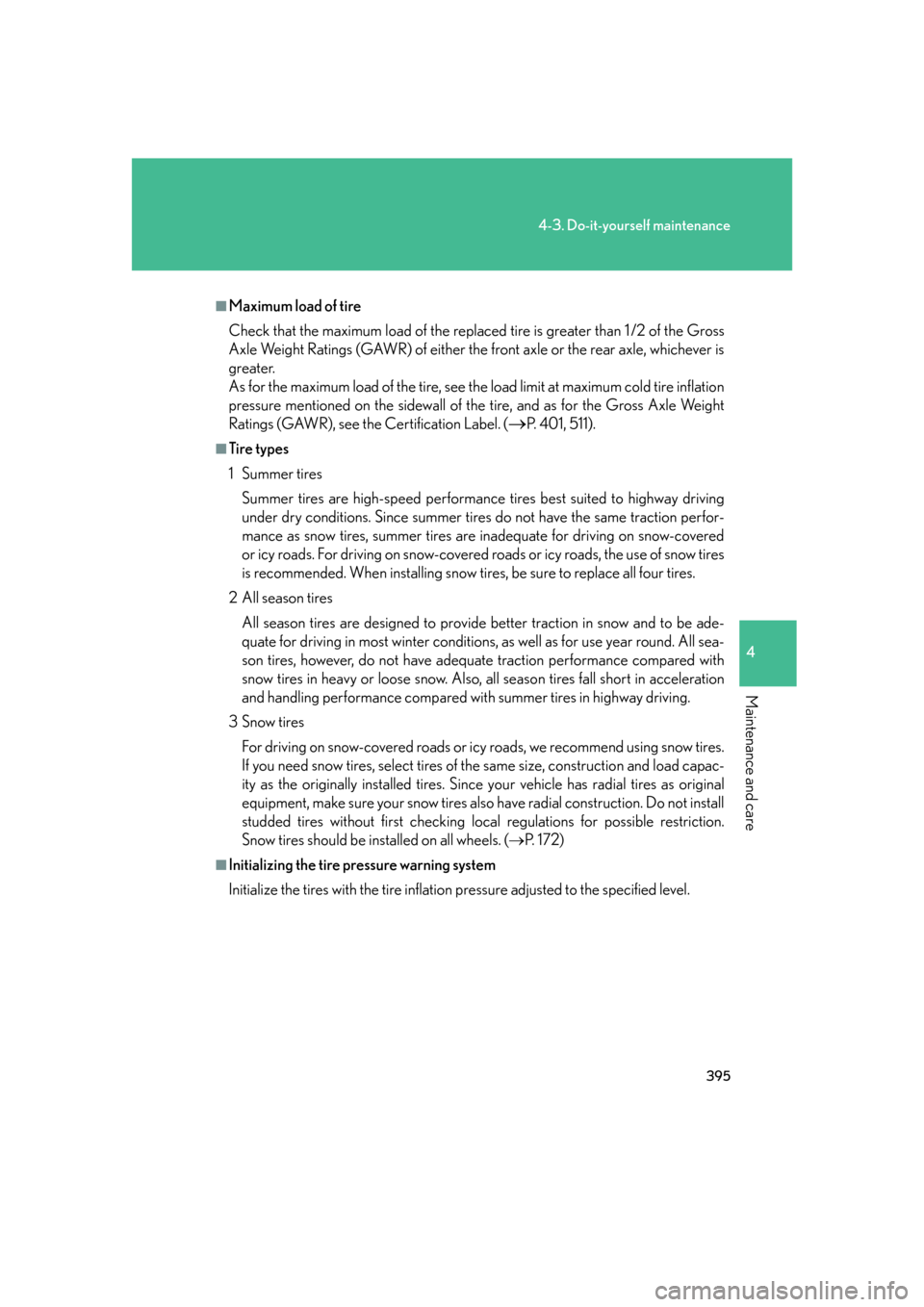
395
4-3. Do-it-yourself maintenance
4
Maintenance and care
■Maximum load of tire
Check that the maximum load of the replaced tire is greater than 1 /2 of the Gross
Axle Weight Ratings (GAWR) of either the front axle or the rear axle, whichever is
greater.
As for the maximum load of the tire, see the load limit at maximum cold tire inflation
pressure mentioned on the sidewall of the tire, and as for the Gross Axle Weight
Ratings (GAWR), see the Certification Label. (
P. 401, 511).
■Tire types
1 Summer tires
Summer tires are high-speed performance tires best suited to highway driving
under dry conditions. Since summer tires do not have the same traction perfor-
mance as snow tires, summer tires are in adequate for driving on snow-covered
or icy roads. For driving on snow-covered roads or icy roads, the use of snow tires
is recommended. When installing snow tires, be sure to replace all four tires.
2 All season tires All season tires are designed to provide better traction in snow and to be ade-
quate for driving in most winter conditions , as well as for use year round. All sea-
son tires, however, do not have adequate traction performance compared with
snow tires in heavy or loose snow. Also, al l season tires fall short in acceleration
and handling performance compared with summer tires in highway driving.
3Snow tires
For driving on snow-covered roads or icy roads, we recommend using snow tires.
If you need snow tires, select tires of the same size, construction and load capac-
ity as the originally installed tires. Since your vehicle has radial tires as original
equipment, make sure your snow tires also have radial construction. Do not install
studded tires without first checking loca l regulations for possible restriction.
Snow tires should be installed on all wheels. ( P. 1 7 2 )
■Initializing the tire pressure warning system
Initialize the tires with the tire inflatio n pressure adjusted to the specified level.
Page 424 of 562
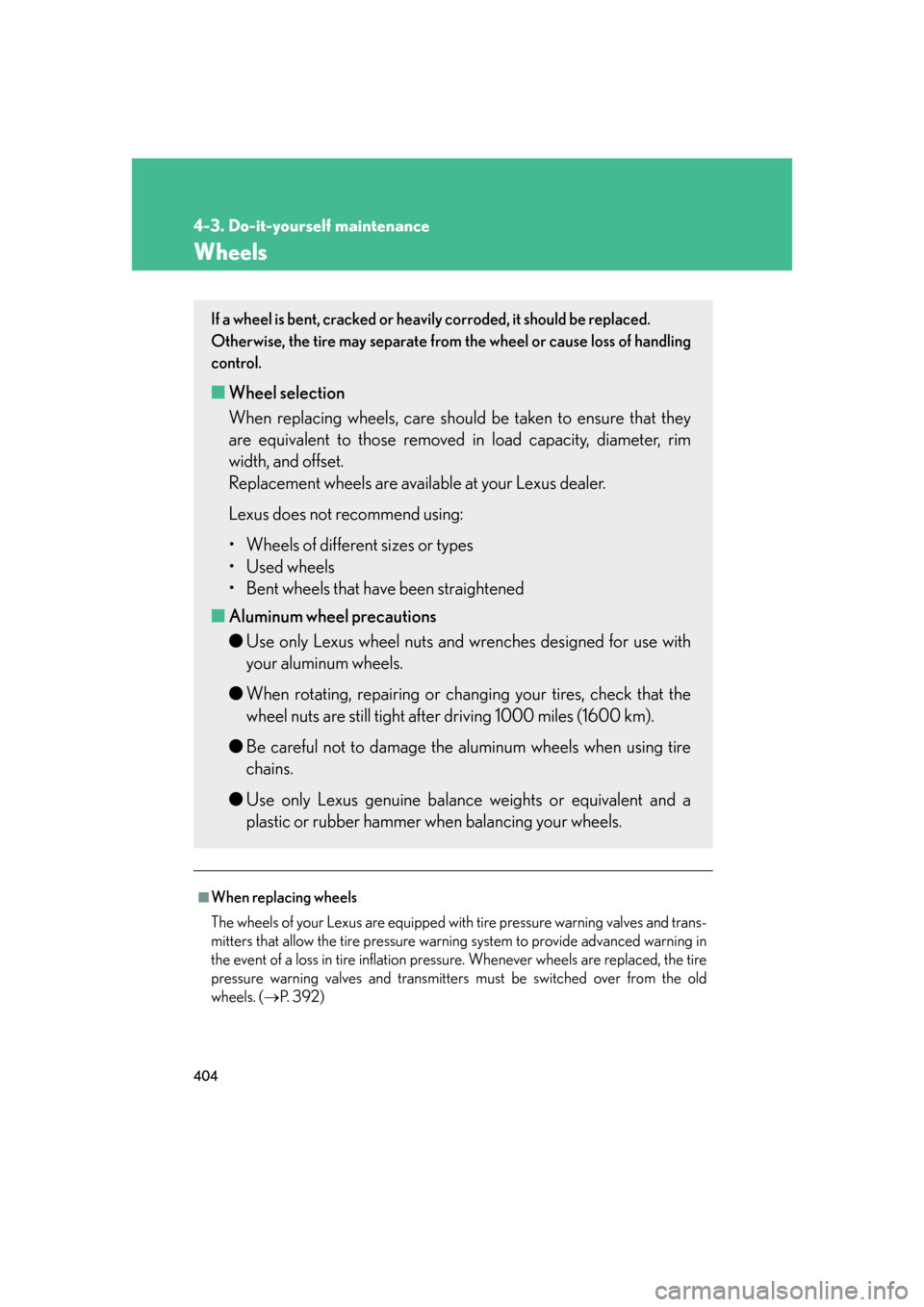
404
4-3. Do-it-yourself maintenance
Wheels
■When replacing wheels
The wheels of your Lexus are equipped with tire pressure warning valves and trans-
mitters that allow the tire pressure warning system to provide advanced warning in
th
e event of a loss in tire inflation pressu re. Whenever wheels are replaced, the tire
pressure warning valves and transmitters must be switched over from the old
wheels. ( P. 3 9 2 )
If a wheel is bent, cracked or heavily corroded, it should be replaced.
Otherwise, the tire may separate from
the wheel or cause loss of handling
control.
■ Wheel selection
When replacing wheels, care should be taken to ensure that they
ar
e equivalent to those removed in load capacity, diameter, rim
width, and offset.
Replacement wheels are available at your Lexus dealer.
Lexus does not recommend using:
• Wheels of different sizes or types
• Used wheels
• Bent wheels that have been straightened
■ Aluminum wheel pr
ecautions
● Use only L
exus wheel nuts and wr enches designed for use with
your aluminum wheels.
● When r
otating, repairing or changi ng your tires, check that the
wheel nuts are still tight after driving 1000 miles (1600 km).
● Be car
eful not to damage the aluminum wheels when using tire
chains.
● Use only L
exus genuine balance weights or equivalent and a
plastic or rubber hammer when balancing your wheels.
Page 525 of 562
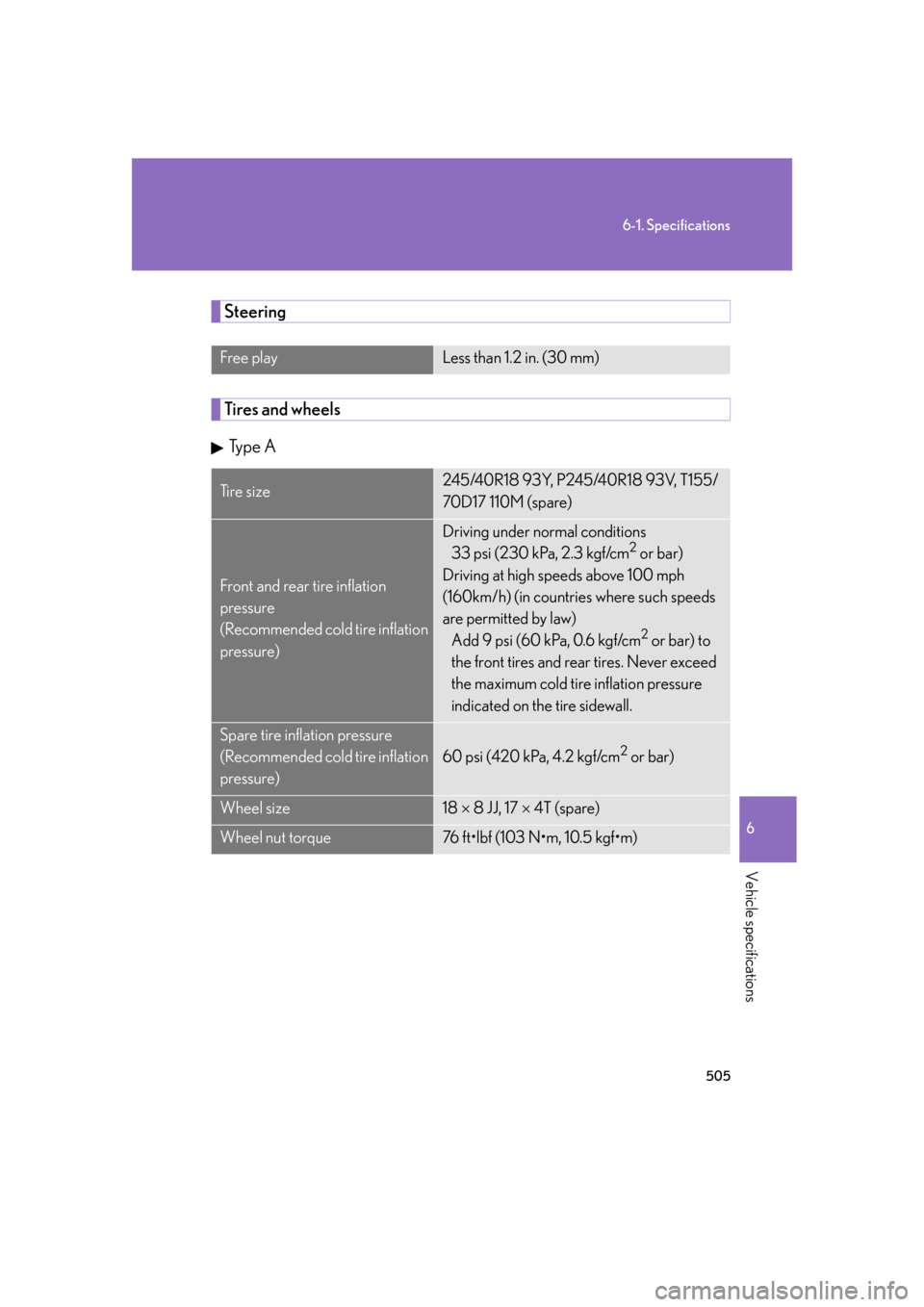
505
6-1. Specifications
6
Vehicle specifications
Steering
Tires and wheels
Type A
Free playLess than 1.2 in. (30 mm)
Ti r e s i z e245/40R18 93Y, P245/40R18 93V, T155/
70D17 110M (spare)
Front and rear tire inflation
pressure
(Recommended cold tire inflation
pressure)
Driving under normal conditions33 psi (230 kPa, 2.3 kgf/cm2 or bar)
Driving at high speeds above 100 mph
(160km/h) (in countries where such speeds
are permitted by law) Add 9 psi (60 kPa, 0.6 kgf/cm
2 or bar) to
the front tires and rear tires. Never exceed
the maximum cold tire inflation pressure
indicated on the tire sidewall.
Spare tire inflation pressure
(Recommended cold tire inflation
pressure)
60 psi (420 kPa, 4.2 kgf/cm2 or bar)
Wheel size18 8 JJ, 17 4T (spare)
Wheel nut torque76 ft•lbf (103 N•m, 10.5 kgf•m)
Page 532 of 562
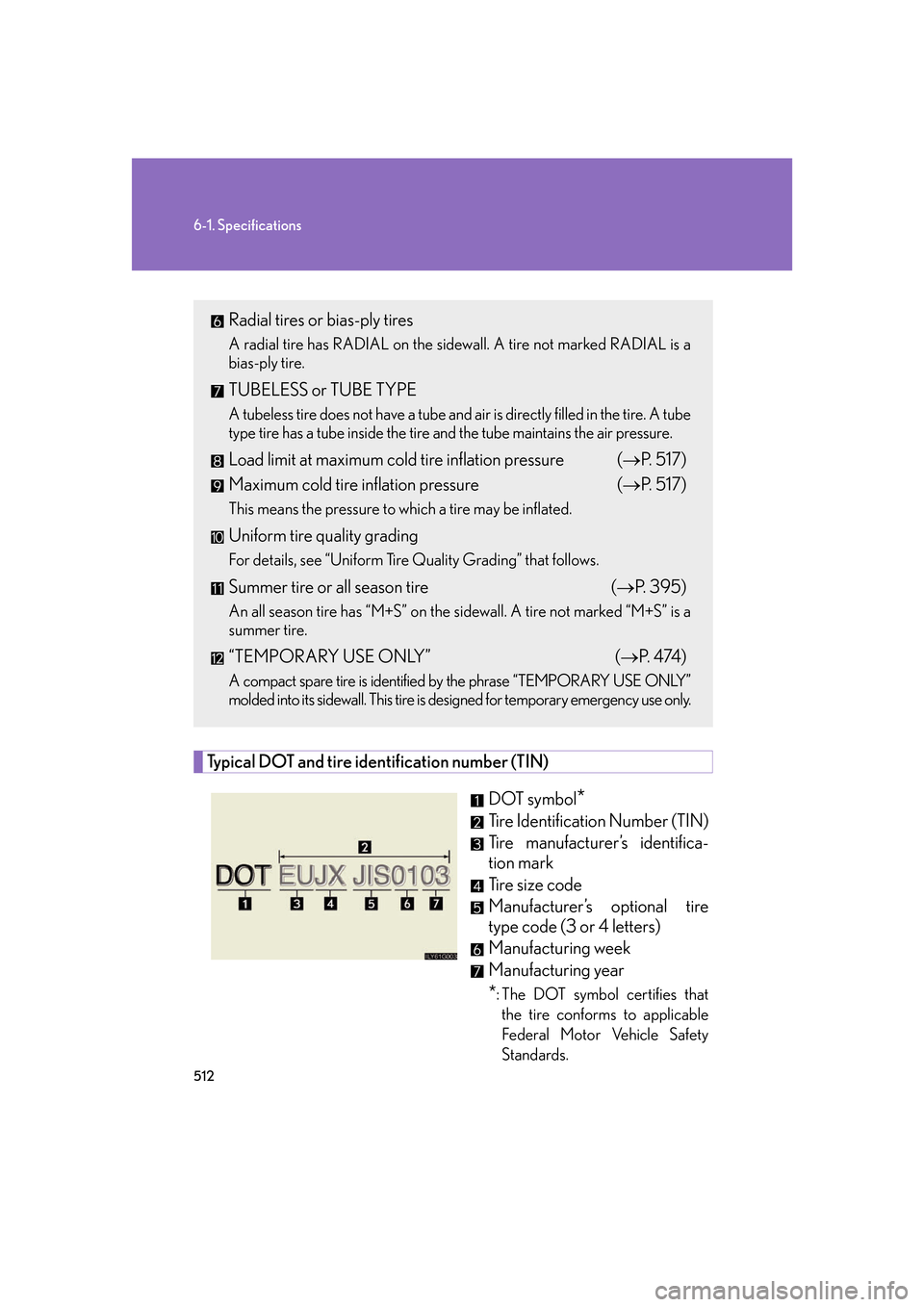
512
6-1. Specifications
Typical DOT and tire identification number (TIN)
DOT symbol*
Tire Identification Number (TIN)
Tire manufacturer’s identifica-
tion mark
Tire size code
Manufacturer’s optional tire
type code (3 or 4 letters)
Manufacturing week
Manufacturing year
*: The DOT symbol certifies that
the tire conforms to applicable
Federal Motor Vehicle Safety
Standards.
Radial tires or bias-ply tires
A radial tire has RADIAL on the sidewall. A tire not marked RADIAL is a
bias-ply tire.
TUBELESS or TUBE TYPE
A tubeless tire does not have a tube and air is directly filled in the tire. A tube
type tire has a tube inside the tire and the tube maintains the air pressure.
Load limit at maximum cold tire inflation pressure ( P. 5 1 7 )
Maximum cold tire inflation pressure ( P. 5 1 7 )
This means the pressure to which a tire may be inflated.
Uniform tire quality grading
For details, see “Uniform Tire Quality Grading” that follows.
Summer tire or all season tire (P. 395)
An all season tire has “M+S” on the si dewall. A tire not marked “M+S” is a
summer tire.
“TEMPORARY USE ONLY” ( P. 4 74 )
A compact spare tire is identified by the phrase “TEMPORARY USE ONLY”
molded into its sidewall. This tire is designed for temporary emergency use only.
Page 537 of 562
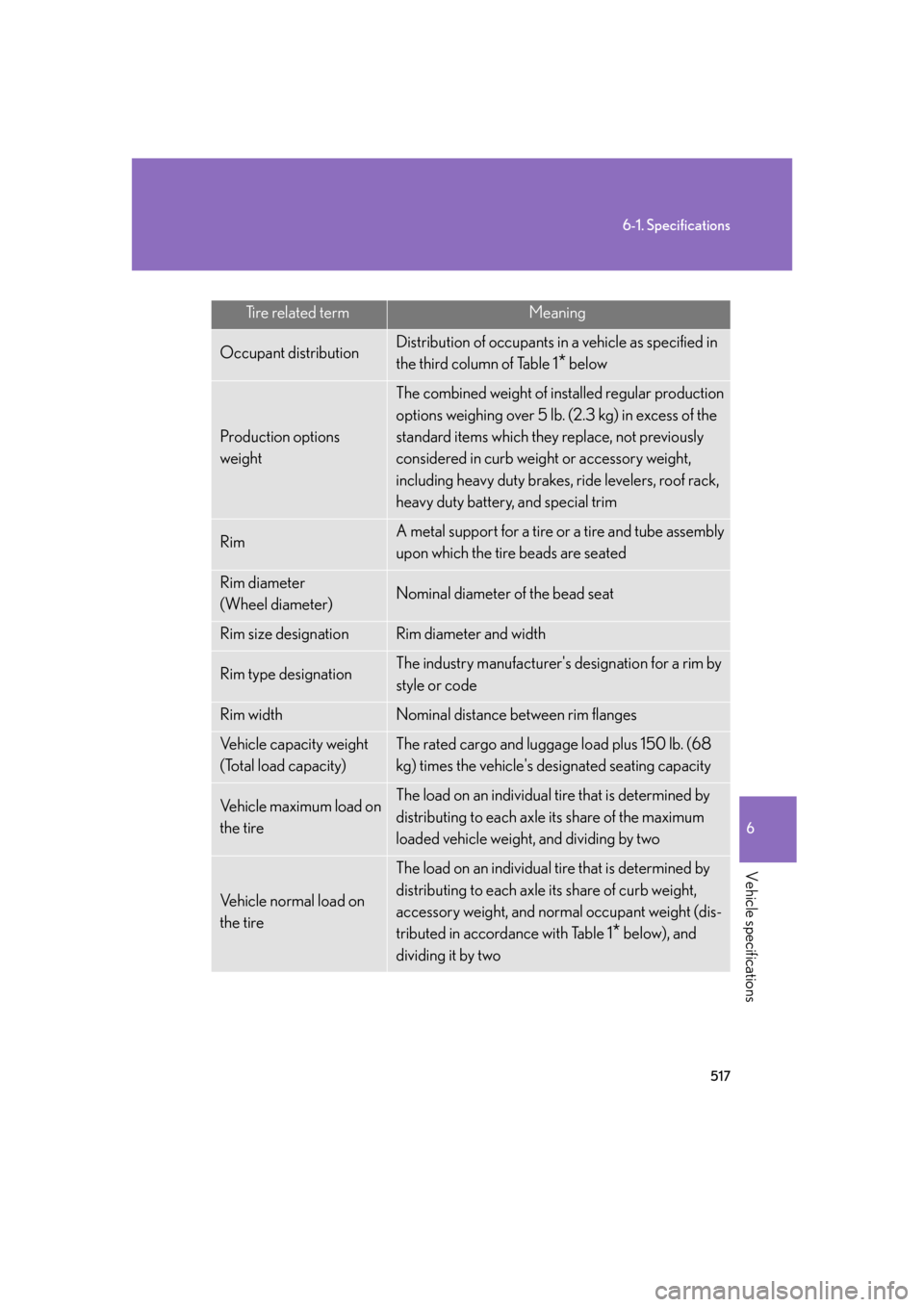
517
6-1. Specifications
6
Vehicle specifications
Tire related termMeaning
Occupant distributionDistribution of occupants in a vehicle as specified in
the third column of Table 1
* below
Production options
weight
The combined weight of installed regular production
options weighing over 5 lb. (2.3 kg) in excess of the
standard items which they replace, not previously
considered in curb weight or accessory weight,
including heavy duty brakes, ride levelers, roof rack,
heavy duty battery, and special trim
RimA metal support for a tire or a tire and tube assembly
upon which the tire beads are seated
Rim diameter
(Wheel diameter)Nominal diameter of the bead seat
Rim size designationRim diameter and width
Rim type designationThe industry manufacturer's designation for a rim by
style or code
Rim widthNominal distance between rim flanges
Vehicle capacity weight
(Total load capacity)The rated cargo and luggage load plus 150 lb. (68
kg) times the vehicle's designated seating capacity
Vehicle maximum load on
the tireThe load on an individual tire that is determined by
distributing to each axle its share of the maximum
loaded vehicle weight, and dividing by two
Vehicle normal load on
the tire
The load on an individual tire that is determined by
distributing to each axle its share of curb weight,
accessory weight, and normal occupant weight (dis-
tributed in accordance with Table 1
* below), and
dividing it by two
Page 562 of 562
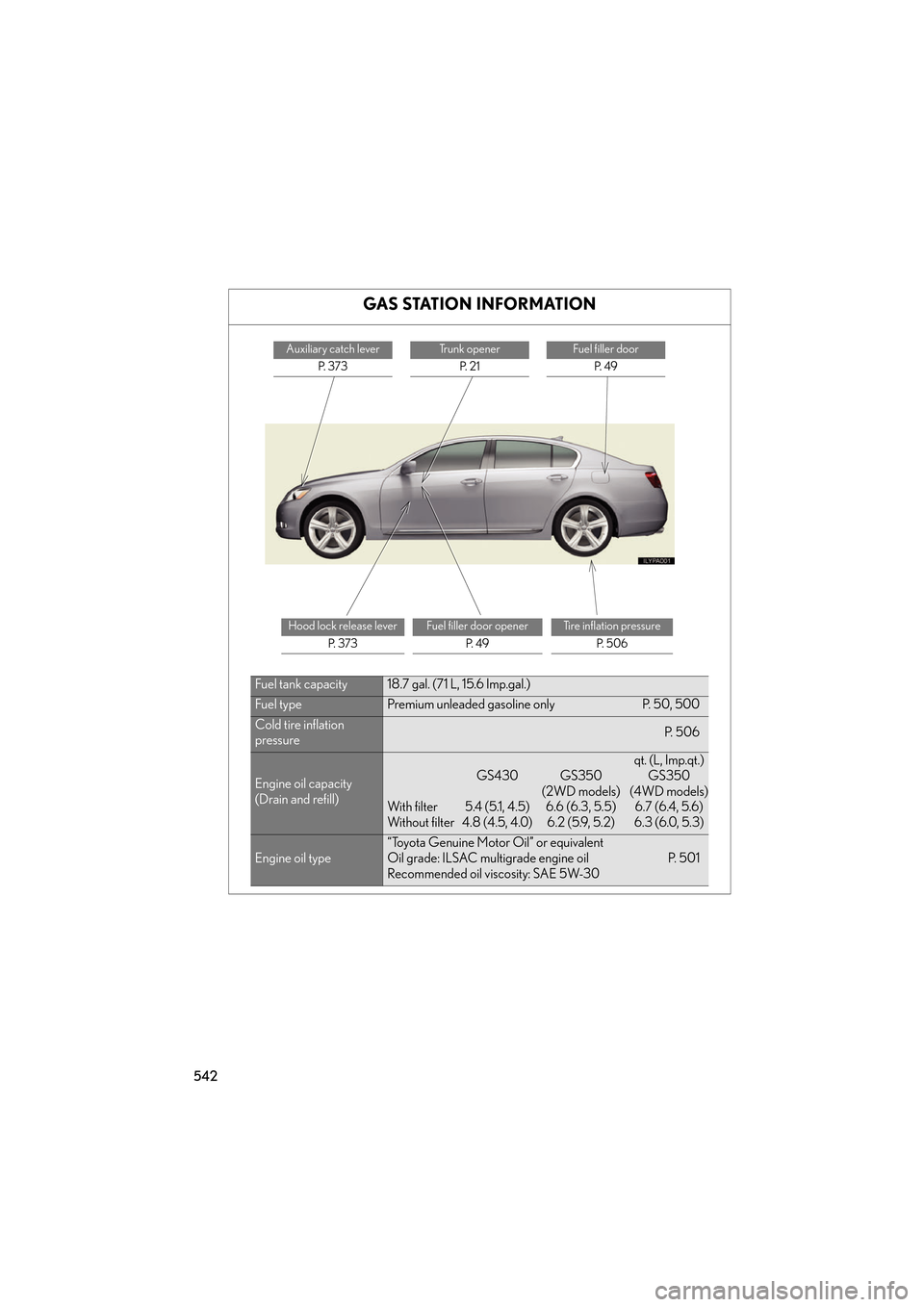
542
GAS STATION INFORMATION
Auxiliary catch leverP. 3 7 3Trunk openerP. 2 1Fuel filler door P. 4 9
Hood lock release lever P. 3 7 3Fuel filler door openerP. 4 9Tire inflation pressureP. 5 0 6
Fuel tank capacity18.7 gal. (71 L, 15.6 lmp.gal.)
Fuel typePremium unleaded gasoline only P. 50, 500
Cold tire inflation
pressureP. 506
Engine oil capacity
(Drain and refill)
qt. (L, Imp.qt.)
GS430 GS350 GS350 (2WD models) (4WD models)
With filter 5.4 (5.1, 4.5) 6.6 (6.3, 5.5) 6.7 (6.4, 5.6)
Without filter 4.8 (4.5, 4.0) 6.2 (5.9, 5.2) 6.3 (6.0, 5.3)
Engine oil type
“Toyota Genuine Motor Oil” or equivalent
Oil grade: ILSAC multigrade engine oil P. 501
Recommended oil viscosity: SAE 5W-30